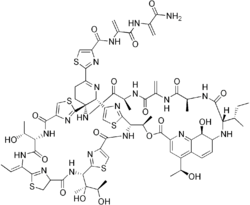Thiopeptide

Thiopeptides (thiazolyl peptides) are a class of peptide antibiotics produced by bacteria. They have antibiotic activity against Gram-positive bacteria, but little or no activity against Gram-negative bacteria.[1] Many of the members of this class show activity against methicillin-resistant Staphylococcus aureus (MRSA) and are therefore subjects of research interest.
There are over 100 members of this class known.[2]
Chemical structure
Thiopeptides are sulfur-rich macrocyclic peptides containing highly-modified amino acids. They are characterized by a nitrogen-containing six-membered ring (such as piperidine, dehydropiperidine, or pyridine) substituted with multiple thiazole rings and dehydroamino acids.[3] A macrocylic ring serves as a scaffold for a tail that also incorporates modified amino acids often with azole rings, such as thiazoles, oxazoles, and thiazolines which are derived from serine, threonine, and cysteine residues.[3]
Examples
Examples of thiopeptides include thiostrepton, cyclothiazomycin, nosiheptide, and lactocillin.
References
- ↑ Bagley, Mark C.; Dale, James W.; Merritt, Eleanor A.; Xiong, Xin (2005). "Thiopeptide Antibiotics". Chemical Reviews. 105 (2): 685. PMID 15700961. doi:10.1021/cr0300441.
- ↑ "THIOBASE: a Database of Thiopeptides Featured in Genetics and Chemistry".
- 1 2 Just-Baringo, X; Albericio, F; Álvarez, M (2014). "Thiopeptide Antibiotics: Retrospective and Recent Advances". Marine Drugs. 12 (1): 317–351. PMC 3917276
 . doi:10.3390/md12010317.
. doi:10.3390/md12010317.